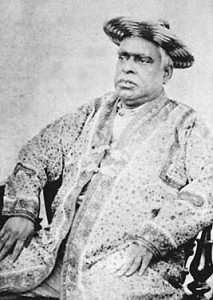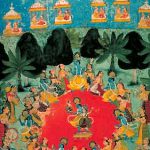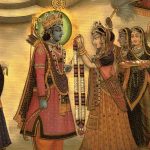 The following is adapted from Reform in Tradition: Bhaktivinoda’s apologetic for the Bhagavat Purana, originally published in Iskcon Communications Journal.
The following is adapted from Reform in Tradition: Bhaktivinoda’s apologetic for the Bhagavat Purana, originally published in Iskcon Communications Journal.
By Krsna Ksetra dasa
As a family man employed in a variety of responsible civil service posts, Kedarnatha Datta Bhaktivinoda was professionally and educationally well acquainted with the intellectual currents swirling through India, and especially through Bengal. In later years, Bhaktivinoda, a prolific writer, would expound extensively on Gaudiya Vaishnava theology and culture, basing his own work on earlier writings of the same school, centering on its late fifteenth and early sixteenth century founder, Sri Caitanya. But these writings came after a sea-change in his thinking, marked by a public speech (in English) in 1869 later published as a pamphlet, The Bhagavata: Its Philosophy, Its Ethics, and Its Theology. Bhaktivinoda was thirty-one years old at the time and had recently secured a position as Deputy Magistrate in the Bengal district of Dinajpur, north of Calcutta.
In his speech at Dinajpur (the one which later became the Bhagavata pamphlet), Bhaktivinoda gives an assessment of the learning he had gathered in earlier years, and the sense of distaste he had developed for the Bhagavatam, having recently rediscovered it:
When we were in college, reading the philosophical works of the West and exchanging thoughts with the thinkers of the day, we had contracted a hatred towards the Bhagavat. That great work seemed like a repository of ideas, scarcely adapted to the nineteenth century, and we hated to hear any argument in its favor. To us then, a volume of Channing, Parker, Emerson, or Newman had more weight than the whole lots of Vaishnava works. Greedily we poured over the various commentations of the Holy Bible and of the labors of the Tattva-Bodhini Sabha, containing extracts from the Upanisads and the Vedanta, but no work of the Vaishnavas had any favor with us.
Bhaktivinoda’s lecture made his position in relation to contending parties clear: What reformers were seeking to imbibe from Western culture could be had in full from the pages of the Bhagavatam for the careful and open-minded reader.
Bhaktivinoda’s The Bhagavata
The Bhagavata is essentially an apologetic work addressed to educated Hindus, but also to sympathizers of Brahmoism, as well as to European Christians who might have sympathies for Hindu reform movements. Originally a public speech, it contains eloquent and sometimes charming rhetoric, appealing to members of his audience to approach the Bhagavatam as a “true critic,” defined as “a generous judge, void of prejudices and party spirit,’ who is ‘of the same disposition of mind as that of the author whose merits he is required to judge.” Such a thoughtful reader or true critic “advises us to preserve what we have already obtained, and to adjust our race from that point where we have arrived in the heat of our progress.” He is not a destroyer of bad ideas, but rather one able to improve bad or old ideas for present purposes.
One thought is a road leading to another. Thus the reader will find that one thought which is the object today will be the means of a further object tomorrow. Thoughts will necessarily continue to be an endless series of means and objects in the progress of humanity.
Opposed to the “true critic” is the “foolish critic,” or the shallow reader, a person who continually urges to “begin anew … because the old masonry does not answer at present” and who thinks, “Let the old author be buried because his time is gone.” It is the foolish critics and superficial readers who fail to bridge the chasms between the various religious persuasions and perpetuate misunderstanding among them. Thus a foolish critic may be either Hindu or Christian and either progressive or orthodox:
One who is trained up in the thoughts of the Unitarian Society or of the Vedanta of the Benares school will scarcely find piety in the faith of Vaishnavas. An ignorant Vaishnava, on the other hand, whose business it is to beg from door to door in the name of Nityananda, will find no piety in the Christians. This is because the Vaishnava does not think in the way in which the Christian thinks of his own religion. It may be that both the Christian and the Vaishnava will utter the same sentiment, but they will never stop their fight with each other only because they have arrived at their common conclusion by different ways of thought.
Although for Bhaktivinoda all parties are guilty of sectarianism, he most keenly felt the unjustified critique of Christians against the Vaishnava tradition: “Thus it is that a great deal of ungenerousness enters into the arguments of the pious Christians when they pass their imperfect opinion on the religion of the Vaishnavas.”
Bhaktivinoda was convinced that the Bhagavatam was a wellspring of higher spirituality which had great promise as the ideal universal scripture. But the Bhagavatam resists easy access and ready appreciation. In his Dinajpur speech, Bhaktivinoda addressed these issues. First, Bhaktivinoda acknowledges the book’s incomprehensibility. Bhaktivinoda writes:
The Bhagavata is undoubtedly a difficult work, and where it does not relate to a picturesque description of traditional and poetical life, its literature is stiff and its branches are covered in the garb of an unusual form of Sanskrit poetry.
In defense of the Bhagavatam, Bhaktivinoda reminds his audience that such is to be expected of a philosophical work, and therefore one must be prepared to take the help of learned commentators to properly understand it: ‘The best commentator is Sridhara Swami and the truest interpreter is our great and noble Caitanyadeva. God bless the spirit of our noble guides.”
The Bhagavatam is not a work for common or “thoughtless” persons. Throughout his talk, Bhaktivinoda urges his Hindu listeners and possible Brahmo sympathizers to rise above mediocrity: the spirit of reform requires first the effort of individuals to comprehend the transcendent nature of reality, and this spirit demands conscious effort:
‘No exertion is necessary to teach the precepts of true religion.’ This is a deceptive idea. It may be true of ethics and the alphabet of religion, but not of the highest form of faith which requires an exalted soul to understand. It certainly requires previous training of the soul in the elements of religion, just as the student of the fractions must have a previous attainment in the elemental numbers and figures in Arithmetic and Geometry. ‘Truth is good’ is an elemental truth which is easily grasped by the common people. But if you tell a common patient that God is infinitely intelligent and powerful in his spiritual nature, he will conceive a different idea from what you entertain of the expression. All higher Truths, although intuitive, require previous education in the simpler ones.
Whereas the thoughtless manage to degrade great ideas of reformers into something they were never meant to be, the great reformers, such as the “Savior of Jerusalem” or the “Savior of Nadia” are not to be scandalized “for these subsequent evils.” Bhaktivinoda concludes his point with a reference to the European Christian reformer: “Luthers, instead of critics, are what we want for the correction of those evils by the true interpretation of the original precepts.”
A second obstacle was the presence of apparent elements of non-rationality: readers of the Bhagavatam schooled in the modern mode of rational thinking might become dismayed by the presence of apparently irrational descriptions therein. Graphic descriptions of heavens and hells meant to “check the evil deeds of ignorant people who are not able to understand the conclusions of philosophy” are found both in “commonplace books of the Hindu religion” as well as in the Bhagavatam. However, Bhaktivinoda warns his readers elsewhere in the work “not to accept them as real facts, but as inventions to overawe the wicked and improve the simple and ignorant.” He assures his audience that the philosophical principle behind these descriptions holds true—that reward and punishment in the future follow present deeds, and that otherwise all poetic inventions besides this spiritual fact have been described as statements borrowed from other works in the way of preservation of old traditions in the book which superseded them and put an end to the necessity of their storage.
Such a distinction is not without controversial implications, even (or especially) for present-day Vaishnavas. Suffice to say here that Bhaktivinoda recognized a potential difficulty for his educated contemporaries to appreciate the Bhagavatam and attempted to resolve it while acknowledging a place for both modern rational thought and traditional culture. For the young Bhaktivinoda of 1869, rationality, following standard Enlightenment thinking, seems to be the gateway to true liberty; but such liberty is not to be had without grappling with the truths of revealed scripture, albeit as an open, not a closed canon:
Our sastras [revealed scriptures], or in other words, books of thought, do not contain all that we could get from the infinite Father. No book is without its errors … . New revelations, therefore, are continually necessary in order to keep truth in its original purity. … (The Bhagavata, 28). We must think for ourselves and try to get further truths which are still undiscovered. In the Bhagavata we have been advised to take the spirit of the sastras and not the words. The Bhagavata is therefore a religion of liberty, unmixed truth, and absolute love.
Bhaktivinoda’s example for such a spirit of truth-seeking is the sage Vyasa, whom he compares to Plato, Jesus, and Caitanya. Having gone “up to the fountainhead of truth, where no pilgrim meets with disappointment of any kind,” Vyasa descended as a transcendental conqueror over the old order. Bhaktivinoda invokes martial imagery to strengthen his point:
Like the great Napoleon in the political world, he knocked down empires and kingdoms of old, as well as bygone philosophies, by the mighty stroke of his transcendental thoughts! This is real power. Atheists, Sankhya philosophers, the followers of Carvaka, the Jains, and the Buddhists shuddered with fear at the approach of the spiritual sentiments and creations of the Bhagavat philosopher!
Thus while there may seem to be elements of non-rationality in the Bhagavatam, the salient feature of the work is the towering theistic message common to all genuine divine revelation.
A third obstacle to be encountered in the Bhagavatam is a further result of improper reading by “shallow critics.” Bhaktivinoda is defending the Bhagavatam against the criticism that it is a justification for lascivious lifestyles, as exhibited by various groups claiming to be followers of Sri Caitanya. Bhaktivinoda refutes this misconception vehemently, concluding that,
Vyasa, who could teach us repeatedly in the whole of the Bhagavata that sensual pleasures are momentary like the pleasures of rubbing the itching hand, and that man’s highest duty is to have spiritual love with God, could never have prescribed the worship of sensual pleasures.
By reading with the proper understanding, Bhaktivinoda promises, a transformation of heart will quickly take place to dispel such misconceptions:
With this advice, dear critic, go through the Bhagavata and I doubt not you will, in three months, weep and repent to God for despising this revelation through the heart and brain of the great Badarayana.
Indeed, this was Bhaktivinoda’s experience not long before delivering this speech. Having thought on first reading in Sri Caitanya-caritamrta that Caitanya recommends the worship of “the improper character of Krishna,” Bhaktivinoda recalls that he prayed, “O God! please give me the understanding by which I may know the secret of this matter.” Shortly thereafter his prayer was answered: ‘The mercy of God is without limit. Seeing my eagerness and humility He showed mercy to me within a few days, and I received the intelligence by which I could understand.
Thus Bhaktivinoda does not deny the existence of obstacles in approaching the Bhagavatam, but they are not insurmountable obstacles, and the reward for the effort is such as to secure for its reader the possibility of becoming a saragrahi, a “seizer of the essence.” To do so requires a process of selective thought:
That fruit of the tree of thought is a composition, as a matter of course, of the sweet and the opposite principles. O men of piety! Like the bee taking honey from the flower, drink the sweet principle and reject that which is not so.
From such statements it might seem that Bhaktivinoda is proposing a new, modern way of reading scripture. Whereas the traditional prescription has always been to read (or, more often, to hear) scripture in an attitude of unquestioning submission, such an attitude does not preclude the necessity to read critically while taking guidance from previous commentators to the work. For such critical reflection Bhaktivinoda presents Vyasa as the prime example. His mature realisation consists of the Bhagavatam, composed after distancing himself from works he had himself previously compiled. Hence, for Bhaktivinoda, Vyasa is proof that the modernway of reading sastra is in fact not new at all, and the fact that Sri Caitanya, the ‘Eastern Saviour,’ exemplified and taught that the Bhagavatam is proof that Indians need not resort to scriptures from outside India as sources of revealed knowledge.
In Bhaktivinoda’s time, in the height of British hegemony in India, he saw in the tradition of Caitanya not a sectarian Hindu solution to modernity, but a tradition of reform which could be built upon to match the challenge of the West with a theologically sound, if misunderstood and neglected, text from the Indian scriptural corpus of revelatory truth. Bhaktivinoda sought to revive and continue that tradition of enlightened reform exemplified by Caitanya, whose message of bhakti to Krishna challenged caste barriers and brought the Bhagavatam forward as the “ripened fruit of the tree of Vedic knowledge.”










